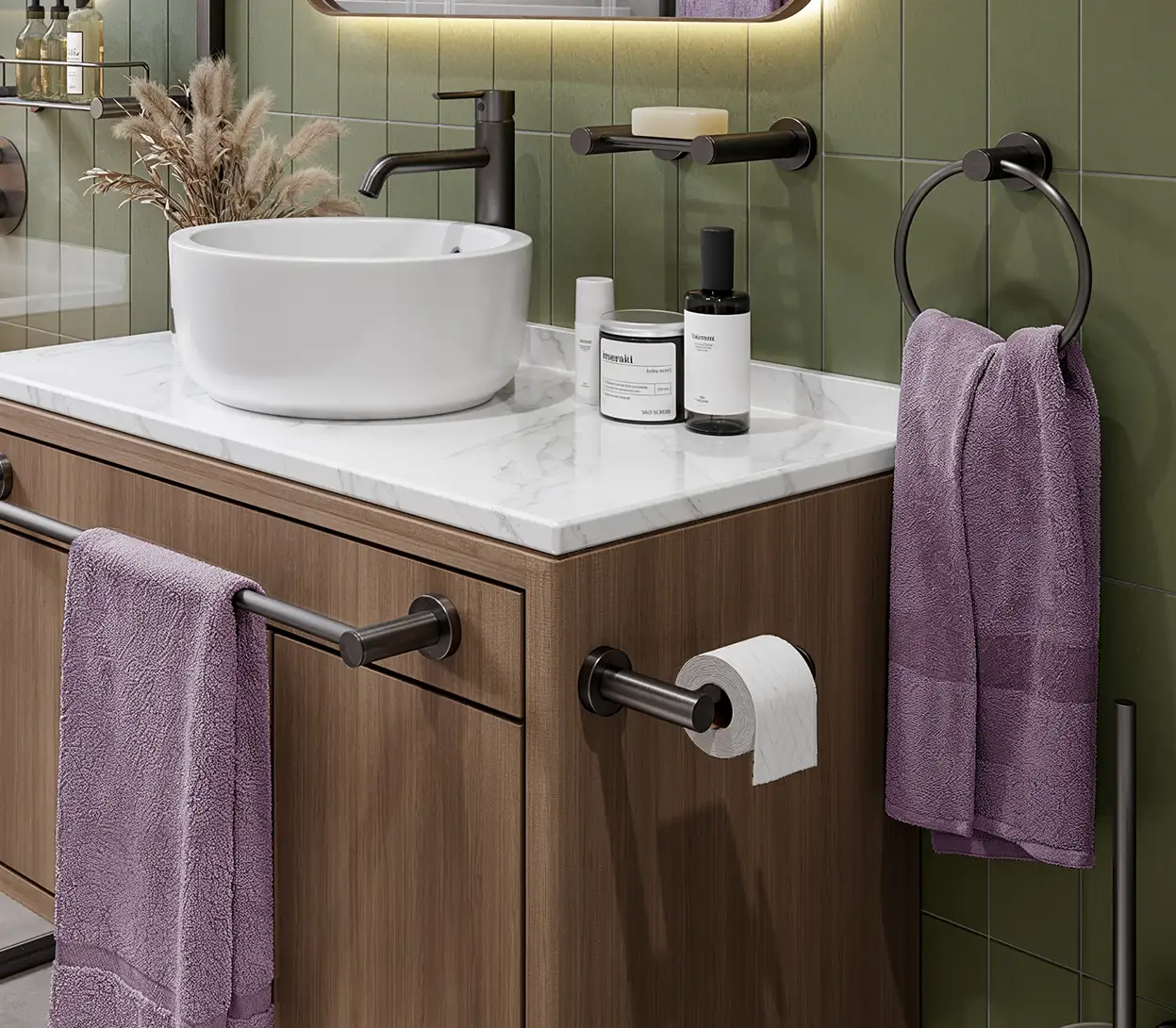Ever wondered why your bathroom towels sometimes smell musty, even after just a few uses? The answer lies in bathroom hygiene, particularly how we dry and care for our towels.
This post will explore why proper towel care is crucial for a healthy bathroom environment and reveal how heated towel racks offer an effective solution.
From reducing the proliferation of bacteria on towels to minimizing laundry loads, discover how these modern fixtures can transform your bathroom into a more hygienic space.
Key takeaways
- Independent testing proves heated towel racks effectively reduce bacterial levels, with a 75% reduction in microbial load over 12 days.
- Rapid drying eliminates the damp conditions bacteria need to multiply, preventing musty odors and extending the freshness of towels between uses.
- Maintaining dry towels between uses reduces cross-contamination in shared bathrooms, especially important for hand towels used by multiple people.
Why is Bathroom Hygiene Important
Most of us focus our cleaning efforts on obvious bathroom surfaces—scrubbing toilets, wiping countertops, and mopping floors.
However, the bathroom’s unique environment creates challenges that go beyond surface cleanliness.
The combination of heat and moisture in this frequently used space makes it particularly vulnerable to bacterial and fungal growth.
Even in well-ventilated bathrooms, water vapor settles on surfaces and seeps into materials, creating ideal conditions for microorganisms to thrive.
Despite regular cleaning routines, these often-overlooked moisture-related issues can compromise your bathroom’s hygiene.

How Towels Impact Bathroom Hygiene
While we rely on towels for drying after washing, they can harbor more microorganisms than you might expect.
Research by microbiologist Dr. Charles Gerba revealed some concerning statistics: 90% of bathroom towels contain coliform bacteria, and 14% carry E. coli – both indicators of fecal contamination. Even more alarming, a square inch of a typical towel can host up to 164,000 bacteria.
Hand towels are particularly problematic in bathrooms.
Used multiple times daily by different people, they quickly become saturated and rarely have time to dry properly between uses. When a hand towel stays damp, bacteria multiply within its fibers, and using it after washing can transfer these bacteria back onto clean hands.
Traditional drying methods compound these issues.
Hanging towels on hooks causes the fabric to bunch together, trapping moisture between folds. In contrast, towels draped over standard towel bars often remain damp in the middle where air circulation is limited. This inadequate drying in a humid bathroom can take hours, creating an ongoing bacterial growth cycle that regular washing alone can’t address.
How Heated Towel Racks Improve Towel Hygiene
Now that we understand the importance of bathroom hygiene and the impact of damp towels, it’s essential to address the challenges they create. Heated towel racks provide an effective solution by actively drying towels, preventing moisture buildup, and maintaining freshness.
Below, we explore their key benefits and how they contribute to a cleaner bathroom environment.

Dry Your Towels Faster
The primary benefit of heated towel racks is their ability to rapidly and thoroughly dry towels, eliminating the moisture and dampness bacteria need to grow.
Bathroom Butler’s innovative Dry Element Technology (DET) sets a new standard for towel drying efficiency.
Unlike fluid-filled models that can take up to 90 minutes to warm up, our heated towel racks are equipped with DET technology and rapid heating, reaching operational temperature in just 15 minutes. The system’s Direct Intelligent Heating (DIH) feature traps heat beneath towels, ensuring thorough and efficient drying.
Just how effective is this approach?
An independent study commissioned by Bathroom Butler identified the microbial bacterial load on damp towels before and after drying.
The results were compelling: heated towel racks reduced bacteria levels from 1000 to 1, with testing over a 12-day period showing a 75% reduction in microbial load.
Prevent Musty Towel Odors
That telltale musty smell from towels signals bacteria and mildew thriving in the fibers.
Heated towel racks maintain a consistent temperature that keeps your towels dry between uses, preventing these unwanted odors from developing.
The result is a fresher bathroom environment without constantly replacing damp, musty towels.
The musty odors in damp towels are primarily caused by bacteria such as Pseudomonas aeruginosa, Staphylococcus, and various fungi that thrive in moist environments.
These microbes feed on organic residues trapped in towel fibers—including dead skin cells, natural oils, soap residue, and body fluids—producing volatile organic compounds (VOCs) like sulfur compounds, fatty acids, and aldehydes as metabolic byproducts.
This process accelerates significantly when towels remain damp for more than 3-4 hours, especially in warm, humid bathrooms.
By rapidly removing the moisture microbes need to multiply and metabolize, heated towel racks slow microbial growth and help prevent odors from forming.

Minimise Cross-Contamination
In shared bathrooms, hand towels can become vectors for bacteria, particularly when used by multiple people throughout the day.
Damp towels create an ideal breeding ground for microbes, increasing the risk of cross-contamination and reintroducing germs to freshly washed hands.
High-traffic bathrooms face the most significant risk, as each user deposits their unique microbiome onto shared towels. In moist conditions, bacteria multiply rapidly, making it easy for the next person to pick up these germs and transfer them to other surfaces or their skin.
This especially concerns individuals with sensitive skin conditions like eczema, where bacterial exposure can trigger infections.
Heated towel racks break this cycle by quickly drying towels, reducing moisture buildup and microbial survival. This significantly lowers the risk of bacteria spreading between users, making them a valuable addition to family and guest bathrooms where hygiene is a priority.
Superior Material for Enhanced Hygiene
In humid bathroom environments, corrosion resistance is essential for long-lasting performance. Materials that rust or degrade over time not only require frequent replacement but can also compromise the look and functionality of bathroom fixtures.
Another exceptional feature of Bathroom Butler’s heated towel racks is their corrosion-resistant Grade 304 Stainless Steel, which ensures superior durability in moisture-rich spaces.
This premium stainless steel maintains its integrity, unlike coated or lower-grade metals that may rust or chip, making it a low-maintenance and long-lasting solution.
Its non-porous surface also prevents bacteria from collecting, adding an extra layer of protection while keeping your towel rack looking pristine for years to come.

Final Thoughts on How Heated Towel Racks Support Bathroom Hygiene
The difference between a hygienic bathroom and one that harbors harmful bacteria may come down to the fixtures we choose and how they support our daily routines.
Heated towel racks keep towels dry between uses, reducing damp conditions that can lead to mildew and musty odors. With corrosion-resistant Grade 304 Stainless Steel, they also ensure durability in humid environments, making them a reliable, long-term solution.
Ready to enhance your bathroom’s hygiene? Explore our range of heated towel racks to find the perfect model for your space.
Interested in learning more?
Our blog features comprehensive guides to bathroom heating solutions, modern renovation ideas, and expert advice on selecting the right fixtures and bathroom accessories for your space.
Discover how to create a bathroom that combines superior hygiene with contemporary style and functionality.




